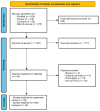Midwife-Led Versus Obstetrician-Led Perinatal Care for Low-Risk Pregnancy: A Systematic Review and Meta-Analysis of 1.4 Million Pregnancies
- PMID: 39597773
- PMCID: PMC11594941
- DOI: 10.3390/jcm13226629
Midwife-Led Versus Obstetrician-Led Perinatal Care for Low-Risk Pregnancy: A Systematic Review and Meta-Analysis of 1.4 Million Pregnancies
Abstract
Background: The optimum model of perinatal care for low-risk pregnancies has been a topic of debate. Obstetrician-led care tends to perform unnecessary interventions, whereas the quality of midwife-led care has been subject to debate. This review aimed to assess whether midwife-led care reduces childbirth intervention and whether this comes at the expense of maternal and neonatal wellbeing. Methods: PubMed, Scopus, Cochrane Library, and Web of Science were systematically searched for relevant studies. Studies were checked for eligibility by screening the titles, abstracts, and full texts. We performed meta-analyses using the inverse variance method using RevMan software version 5.3. We pooled data using the risk ratio and mean difference with the 95% confidence interval. Results: This review included 44 studies with 1,397,320 women enrolled. Midwife-led care carried a lower risk of unplanned cesarean and instrumental vaginal deliveries, augmentation of labor, epidural/spinal analgesia, episiotomy, and active management of labor third stage. Women who received midwife-led care had shorter hospital stays and lower risks of infection, manual removal of the placenta, blood transfusion, and intensive care unit (ICU) admission. Furthermore, neonates delivered under midwife-led care had lower risks of acidosis, asphyxia, transfer to specialist care, and ICU admission. Postpartum hemorrhage, perineal tears, APGAR score < 7, and other outcomes were comparable between the two models of management. Conclusions: Midwife-led care reduced childbirth interventions with favorable maternal and neonatal outcomes in most cases. We recommend assigning low-risk pregnancies to midwife-led perinatal care in health systems with infrastructure allowing for smooth transfer when complications arise. Further research is needed to reflect the situation in low-resource countries.
Keywords: childbirth; low-risk; meta-analysis; midwife; obstetrician.
Conflict of interest statement
Author Fahad M. Almutairi was employed by Health Holding Company, Ministry of Health, Jeddah, Saudi Arabia. The remaining authors declare that the research was conducted in the absence of any commercial or financial relationships that could be construed as a potential conflict of interest.
Figures







Similar articles
-
Intrapartum and neonatal mortality in low-risk term women in midwife-led care and obstetrician-led care at the onset of labor: A national matched cohort study.Acta Obstet Gynecol Scand. 2020 Apr;99(4):546-554. doi: 10.1111/aogs.13767. Epub 2019 Dec 11. Acta Obstet Gynecol Scand. 2020. PMID: 31713236
-
Comparison of midwife-led care and obstetrician-led care on maternal and neonatal outcomes in Singapore: A retrospective cohort study.Midwifery. 2017 Oct;53:71-79. doi: 10.1016/j.midw.2017.07.010. Epub 2017 Jul 18. Midwifery. 2017. PMID: 28778037
-
Obstetrician involvement in planned midwife-led births: a cohort study in an obstetric department of a University Hospital in Switzerland.BMC Pregnancy Childbirth. 2021 Oct 27;21(1):728. doi: 10.1186/s12884-021-04209-2. BMC Pregnancy Childbirth. 2021. PMID: 34706693 Free PMC article.
-
Effectiveness of midwifery-led care on pregnancy outcomes in low- and middle-income countries: a systematic review and meta-analysis.BMC Pregnancy Childbirth. 2023 May 26;23(1):386. doi: 10.1186/s12884-023-05664-9. BMC Pregnancy Childbirth. 2023. PMID: 37237358 Free PMC article.
-
Emergency delivery in pregnancies at high probability of placenta accreta spectrum on prenatal imaging: a systematic review and meta-analysis.Am J Obstet Gynecol MFM. 2024 Oct;6(10):101432. doi: 10.1016/j.ajogmf.2024.101432. Epub 2024 Jul 26. Am J Obstet Gynecol MFM. 2024. PMID: 39069207
Cited by
-
Efficacy of birthing ball exercises to reduce labor pain and cesarean rates: an updated meta-analysis of randomized controlled trials.Arch Gynecol Obstet. 2025 May;311(5):1331-1341. doi: 10.1007/s00404-024-07930-3. Epub 2025 Jan 18. Arch Gynecol Obstet. 2025. PMID: 39825901 Free PMC article.
-
The birthing experience among Indian antenatal mothers in a midwifery-led care unit: A systematic literature review.Bioinformation. 2025 May 31;21(5):1042-1045. doi: 10.6026/973206300211042. eCollection 2025. Bioinformation. 2025. PMID: 40822773 Free PMC article.
-
Effect of midwife-led care models on maternal and fetal outcomes: A scoping review.Bioinformation. 2025 May 31;21(5):957-961. doi: 10.6026/973206300210957. eCollection 2025. Bioinformation. 2025. PMID: 40822759 Free PMC article.
References
Publication types
LinkOut - more resources
Full Text Sources

